Home / Infrared (IR) Spectroscopy: A Quick Primer On Interpreting Spectra
Spectroscopy
Infrared (IR) Spectroscopy: A Quick Primer On Interpreting Spectra
Last updated: October 27th, 2025 |
How To Interpret IR Spectra In 1 Minute Or Less: The 2 Most Important Things To Look For [Tongue and Sword]
Last post, we briefly introduced the concept of bond vibrations, and we saw that we can think of covalent bonds as a bit like balls and springs: the springs vibrate, and each one “sings” at a characteristic frequency, which depends on the strength of the bond and on the masses of the atoms. These vibrations have frequencies that are in the mid-infrared (IR) region of the electromagnetic spectrum.
We can observe and measure this “singing” of bonds by applying IR radiation to a sample and measuring the frequencies at which the radiation is absorbed. The result is a technique known as Infrared Spectroscopy, which is a useful and quick tool for identifying the bonds present in a given molecule.
We saw that the IR spectrum of water was pretty simple – but moving on to a relatively complex molecule like glucose (below) we were suddenly confronted with a forest of peaks!
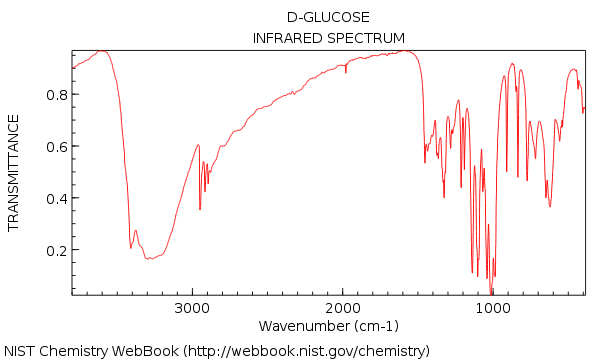
Your first impression of looking at that IR might be: agh! how am I supposed to make sense of that??
To which I want to say: don’t panic!
Table of Contents
- Let’s Correct Some Common Misconceptions About IR
- Starting With “Hunt And Peck” Is Not The Way To Go
- IR Spectroscopy: The Big Picture
- The Two Main Things To Look For In An IR Spectrum: “Tongues” and “Swords”.
- Alcohols and Carboxylic Acids: More Detail
- Specific Examples of IR Spectra of Carbonyl Functional Groups
- Less Crucial, But Still Useful: Two More Very Diagnostic Areas.
- Glucose, Revisited: The 1 Minute Analysis
- Quiz Yourself!
- Notes
1. Let’s Correct Some Common Misconceptions About IR
In this post, I want to show that a typical analysis of an IR spectrum is much simpler than you might think. In fact, once you learn what to look for, it can often be done in a minute or less. Why?
- IR is not generally used to determine the whole structure of an unknown molecule. For example, there isn’t a person alive who could look at the IR spectrum above and deduce the structure of glucose from it. IR is a tool with a very specific use. [Back in 1945 when IR was one of the few spectral techniques available, it was necessary to spend a lot more time trying to squeeze every last bit of information out of the spectrum. Today, with access to NMR and other techniques, we can do more cherry-picking]
- We don’t need to analyze every single peak ! (as we’ll see later, that’s what NMR is for : – ) ). Instead, IR is great for identifying certain specific functional groups, like alcohols and carbonyls. In this way it’s complimentary to other techniques (like NMR) which don’t yield this information as quickly.
With this in mind, we can simplify the analysis of an IR spectrum by cutting out everything except the lowest-lying fruit.
See that forest of peaks from 500-1400 cm-1 ? We’re basically going to ignore them all!
80% of the most useful information for our purposes can be obtained by looking at two specific areas of the spectrum: 3200-3400 cm-1 and 1650-1800 cm-1. We’ll also see that there are at least two more regions of an IR spectrum worth glancing at, and thus conclude a “first-order” analysis of the IR spectrum of an unknown. [We might write a subsequent post which gets nittier and grittier about the finer points of analyzing an IR spectrum]
Bottom line: The purpose of this post is to show you how to prioritize your time in an analysis of an IR spectrum.
[BTW: all spectra are from the NIST database. Thank you, American taxpayers!]
2. Starting With “Hunt And Peck” Is Not The Way To Go
Confronted with an IR spectrum of an unknown (and a sense of rising panic), what does a typical new student do?
They often reach for the first tool they are given, which is a table of common ranges for IR peaks given to them by their instructor.
The next step in their analysis is to go through the spectrum from one side to the next, trying to match every single peak to one of the numbers in the table. I know this because this is exactly what I did when I first learned IR. I call it “hunting and pecking”.
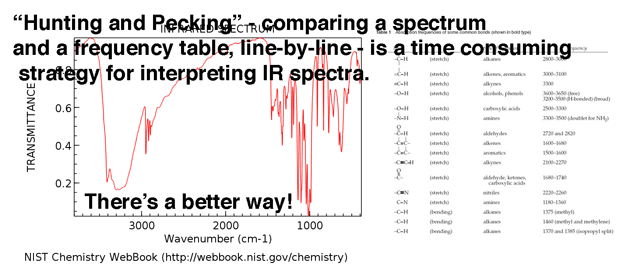
The only people who “hunt and peck” as their first step are people who have no plan (i.e. “newbies”).
So by reading the next few paragraphs you can save yourself a lot of time and confusion.
[Hunt and peck has its place, but only AFTER you’ve looked for “tongues” and “swords”, below. Hunting and pecking is great to make sure you didn’t miss anything big – but as a first step, it’s bloody awful!]
3. The Big Picture
In IR spectroscopy we measure where molecules absorb photons of IR radiation. The peaks represent areas of the spectrum where specific bond vibrations occur. [for more background, see the previous post, especially on the “ball and spring” model]. Just like springs of varying weights vibrate at characteristic frequencies depending on mass and tension, so do bonds.
Here’s an overview of the IR window from 4000 cm -1 to 500 cm -1 with various regions of interest highlighted.
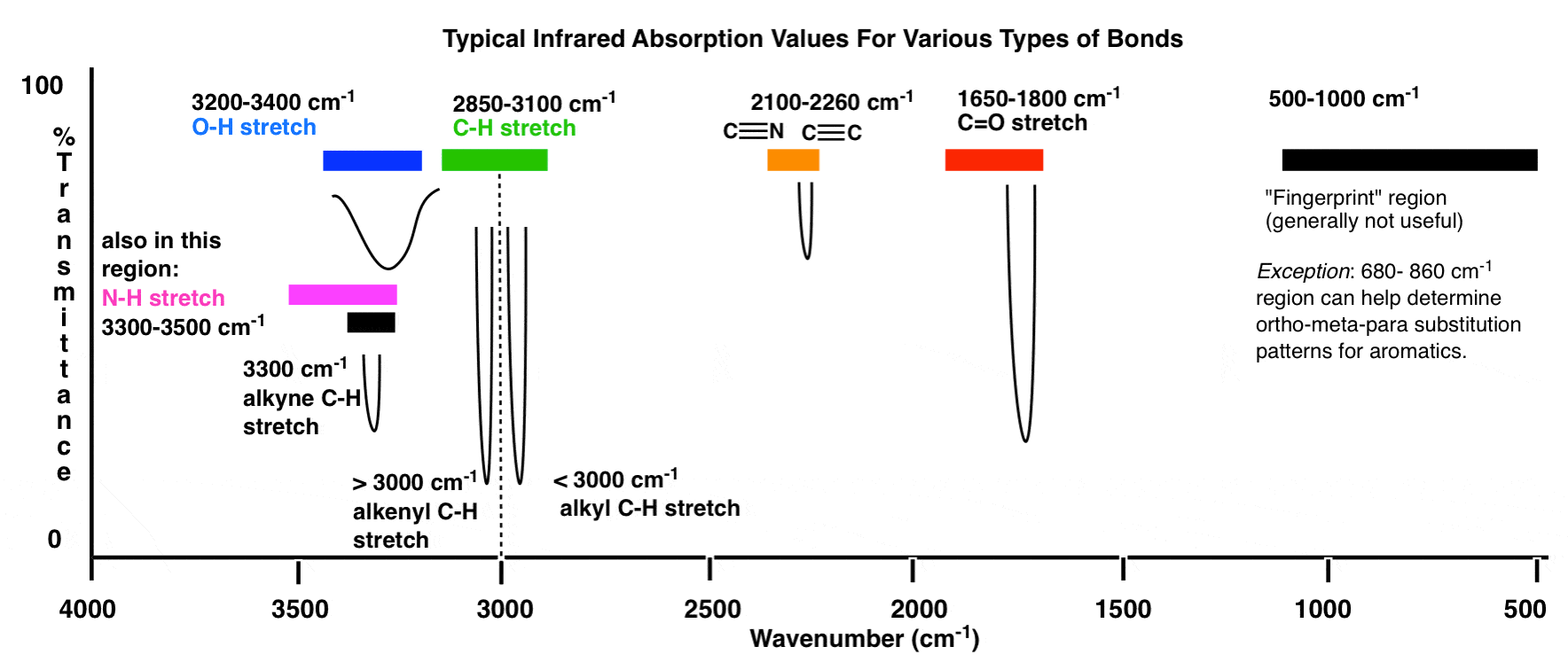
An even more compressed overview looks like this: (source)
| 3600 – 2700 cm-1 | X-H (single bonds to hydrogen) |
| 2700 – 1900 cm-1 | X≡X (triple bonds) |
| 1900 – 1500 cm-1 | X=X (double bonds) |
| 1500 – 500 cm -1 | X–X (single bonds) |
Within these ranges, there are two high-priority areas to focus on, and two lesser-priority areas we’ll discuss further below. Chicken
4. The Two Main Things To Look For In An IR Spectrum: “Tongues” and “Swords”.
When confronted with a new IR spectrum, prioritize your time by asking two important questions:
- Is there a broad, rounded peak in the region around 3400-3200 cm-1 ? That’s where hydroxyl groups (OH) appear.
- Is there a sharp, strong peak in the region around 1850-1630 cm-1 ? That’s where carbonyl groups (C=O) show up.
First, let’s look at some examples of hydroxyl group peaks in the 3400 cm-1 to 3200 cm-1 region, which Jon describes vividly as “tongues”. The peaks below all belong to alcohols. Hydrogen bonding between hydroxyl groups leads to some variations in O-H bond strength, which results in a range of vibrational energies. The variation results in the broad peaks observed.
Hydroxyl groups that are a part of carboxylic acids have an even broader appearance that we’ll describe in a bit.
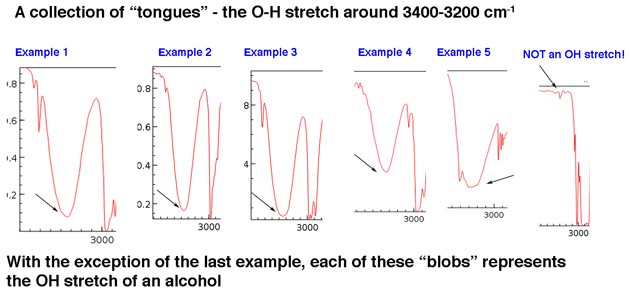
[Sometimes it helps to know what not to look for. On the far right hand side is included one example of a very weak peak on a baseline that you can safely ignore.]
The main point is that a hydroxyl group isn’t generally something you need to go looking for in the baseline noise.
Although hydroxyl groups are the most common type of broad peak in this region, N-H peaks can show up in this area as well (more on them in the Note 1). They tend to have a sharper appearance and may appear as one or two peaks depending on the number of N-H bonds.
Next, let’s look at some examples of C=O peaks, in the region around 1630-1800 cm-1.. These peaks are almost always the strongest peaks in the entire spectrum and are relatively narrow, giving them a somewhat “sword-like” appearance.
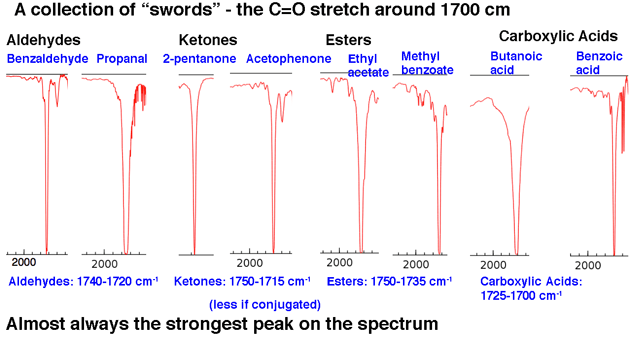
That sums up our 80/20 analysis: look for tongues and swords.
If you learn nothing else from this post, learn to recognize these two types of peaks!
Two other regions of the IR spectrum can quickly yield useful information if you train yourself to look for them.
3. The line at 3000 cm-1 is a useful “border” between alkene C–H (above 3000 cm-1) and alkane C–H (below 3000 cm-1 ) This can quickly help you determine if double bonds are present.
4. A peak in the region around 2200 cm-1 – 2050 cm-1 is a subtle indicator of the presence of a triple bond [C≡N or C≡C] . Nothing else shows up in this region.
A Common Sense Reminder
First, some obvious advice:
- if you’re given the molecular formula, that will determine what functional groups you should look for. It makes no sense to look for OH groups if you have no oxygens in your molecular formula, or likewise the presence of an amine if the formula lacks nitrogen.
- Less obviously, calculate the degrees of unsaturation if you are given the molecular formula, because it will provide important clues. Don’t look for C=O in a structure like C4H10O which doesn’t have any degrees of unsaturation.
5. Alcohols and Carboxylic Acids: More Detail
Alcohols
Let’s look at a specific example so we can see everything in perspective. The spectrum below is of 1-hexanol.
Note the hydroxyl group peak around 3300 cm-1 , typical of an alcohol (That sharp peak around 3600 cm-1 is a common companion to hydroxyl peaks: it represents non-hydrogen bonded O-H).
As you’d expect for 1-hexanol, there isn’t any telltale carbonyl peak around 1700 cm-1. Beginners might be tempted to label that dagger-like strong peak at about 1450 cm-1 as a possible C=O stretch. It is not. (it’s likely a C-H bend). Variations only occur within a very narrow range, and you are extremely unlikely to see a C=O stretch much below 1650 cm-1. The more spectra you see, the better you’ll get at making these judgements.
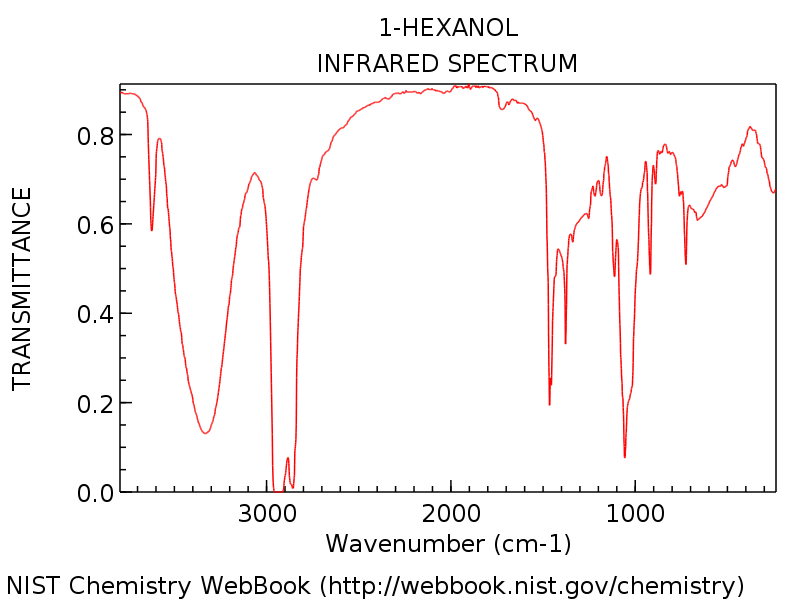
To gain some familiarity with variation, here’s some more examples of entire IR spectra of various alcohols.
Carboxylic Acids
Hydroxyl groups in carboxylic acids are considerably broader than in alcohols. Jon calls it a “hairy beard”, which is a perfect description. Their appearance is also highly variable. The OH absorption in carboxylic acids can be so broad that it extends below 3000 cm-1 , pretty much “taking over” the left hand part of the spectrum.
Here’s an example: butanoic acid.
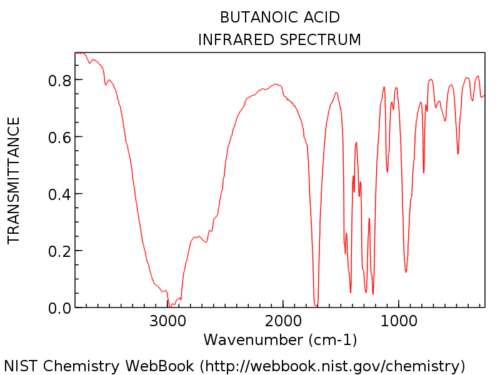
Here’s some more examples of full spectra so you can see the variation.
The difference in appearance between the OH of an alcohol and that of a carboxylic acid is usually diagnostic. In the rare case where you aren’t sure whether the broad peak is due to the OH of an alcohol or a carboxylic acid, one suggestion is to check the region around 1700 cm for the C=O stretch. If it’s absent, you are likely looking at an alcohol.
[Note 1 for more detail on the 3200-3500 cm-1 region : Amines, Amides, and Terminal Alkynes]
6. Specific Examples of IR Spectra of Carbonyl Functional Groups
The second important peak region is the carbonyl C=O stretch area at about 1630-1830 cm. Carbonyl stretches are sharp and strong.
Once you see a few of them they’re impossible to miss. Nothing else shows up in this region.
To put it in perspective, here’s the IR spectrum of hexanal. That peak a little after 1700 cm-1 is the C=O stretch. When it’s present, the C=O stretch is almost always the strongest peak in the IR spectrum and impossible to miss.
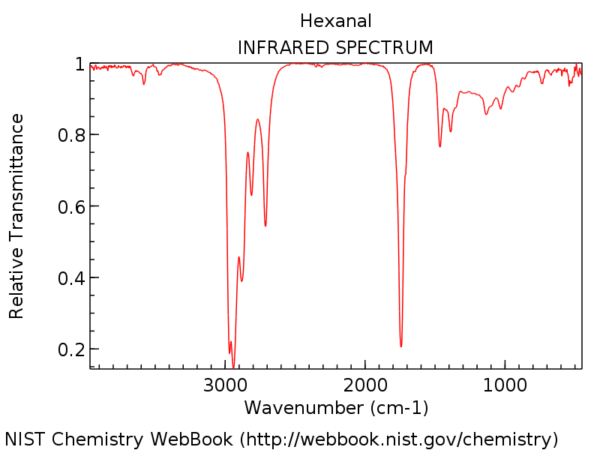
The position of the C=O stretch varies slightly by carbonyl functional group. Some ranges (in cm-1 ) are shown below:
- Aldehydes (1740-1690): benzaldehyde, propanal, pentanal
- Ketones (1750-1680): 2-pentanone, acetophenone
- Esters (1750-1735): ethyl acetate, methyl benzoate
- Carboxylic acids (1780-1710): benzoic acid, butanoic acid
- Amide (1690-1630): acetamide, benzamide, N,N-dimethyl formamide (DMF)
- Anhydrides (2 peaks; 1830-1800 and 1775-1740): acetic anhydride, benzoic anhydride
Conjugation will affect the position of the C=O stretch somewhat, moving it to lower wavenumber.
A decent rule of thumb is that you will never, ever see a C=O stretch below 1630. If you see a strong peak at 1500, for example, it is not C=O. It is something else.
7. Less Crucial, But Still Useful: Two More Very Diagnostic Areas.
- The C-H Stretch Boundary at 3000 cm-1
3000 cm-1 serves as a useful dividing line. Above this line is observed higher frequency C-H stretches we attribute to sp2 hybridized C-H bonds. Two examples below: 1-hexene (note the peak that stands a little higher) and benzene.
For a molecule with only sp3-hybrized C-H bonds, the lines will appear below 3000 cm-1 as in hexane, below.
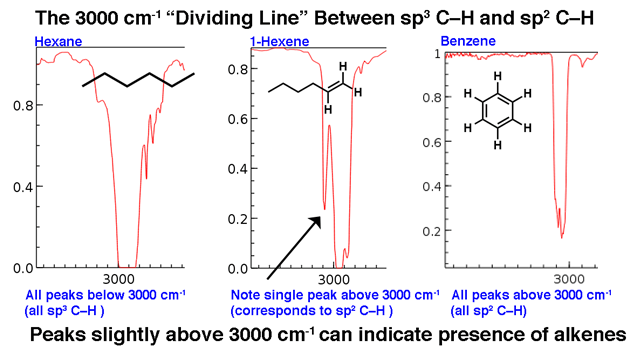
2. The Distinctive Triple Bond Region around 2200 cm-1
Molecules with triple bonds appear relatively infrequently in the grand scheme of things, but when they do, they do have a distinctive trace in the IR.
The region between 2000 cm-1 and 2400 cm-1 is a bit of a “ghost town” in IR spectra; there’s very little that appears in this region. If you do see peaks in this region, a likely candidate is a triple bonded carbon such as an alkyne or nitrile.
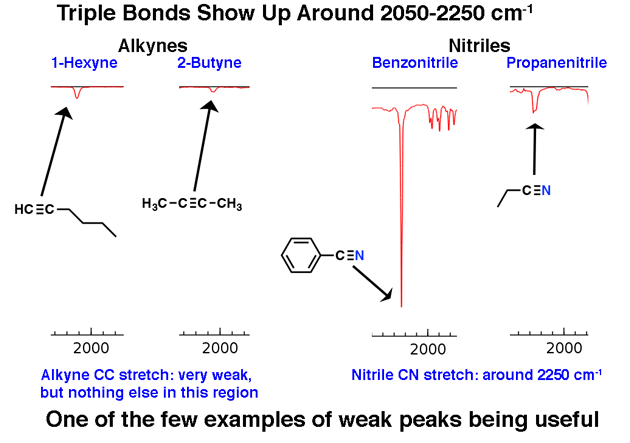
Note how weak the alkyne peaks are. This is one exception to the rule that one should ignore weak peaks. Still, caution is required: if you’re given the molecular formula, confirm that an alkyne is possible by calculating the degrees of unsaturation and ensuring that it is at least 2 or more.
Terminal alkynes (such as 1-hexyne) also have a strong C-H stretch around 3400 cm-1 that is more strongly diagnostic.
8. Glucose, Revisited: The 1 Minute Analysis
OK. We’ve gone over 4 regions that are useful for a quick analysis of an IR spectrum.
- (important!) O-H around 3200-3400 cm-1
- (important!) C=O around 1700 cm-1
- C-H dividing line at 3000 cm-1
- (rare) Triple bond region around 2050-2250 cm-1
Now let’s go back and look at the IR of glucose. What do we see?
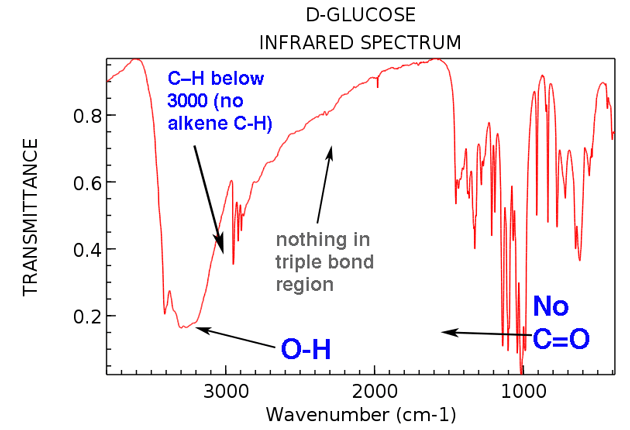
Here are the two big things to note:
- OH present around 3300 cm-1 . (in fact, this was included as one of the “swords” in section #3, above)
- No C=O stretch present. No strong peak around 1700 cm-1 . (The peak at 1450 cm-1 isn’t a C=O stretch).
Also, if we take a bit of extra time we can see:
- No alkene C-H (no peaks above 3000 cm-1 )
- Nothing in triple bonded region (rare, but still an easy thing to learn to check)
Now: If you were given this spectrum as an “unknown” along with its molecular formula, C6H12O6, what conclusions could you draw about its structure?
- The molecule has at least one OH group (and possibly more)
- The molecule doesn’t have any C=O groups
- The molecule *likely* doesn’t have any alkenes. If any alkenes are present, they don’t bear any C-H bonds, because we’d see their C-H stretch above 3000 cm-1.
A molecule with one degree of hydrogen deficiency (C6H12O6) but no C=O, and likely no C=C ?
A good guess would be that the molecule contains a ring. (We know this is the case, of course, but it’s nice to see the IR confirming what we already know).
This is what a 1-minute analysis of the IR of glucose can tell us. Not the whole structure, mind you, but certainly some important bits and pieces.
That’s enough for today. In the next post we’ll do some more 1-minute analyses and give more concrete examples of how to use the information in an IR spectrum to draw conclusions about molecular structure.
Quiz Yourself!
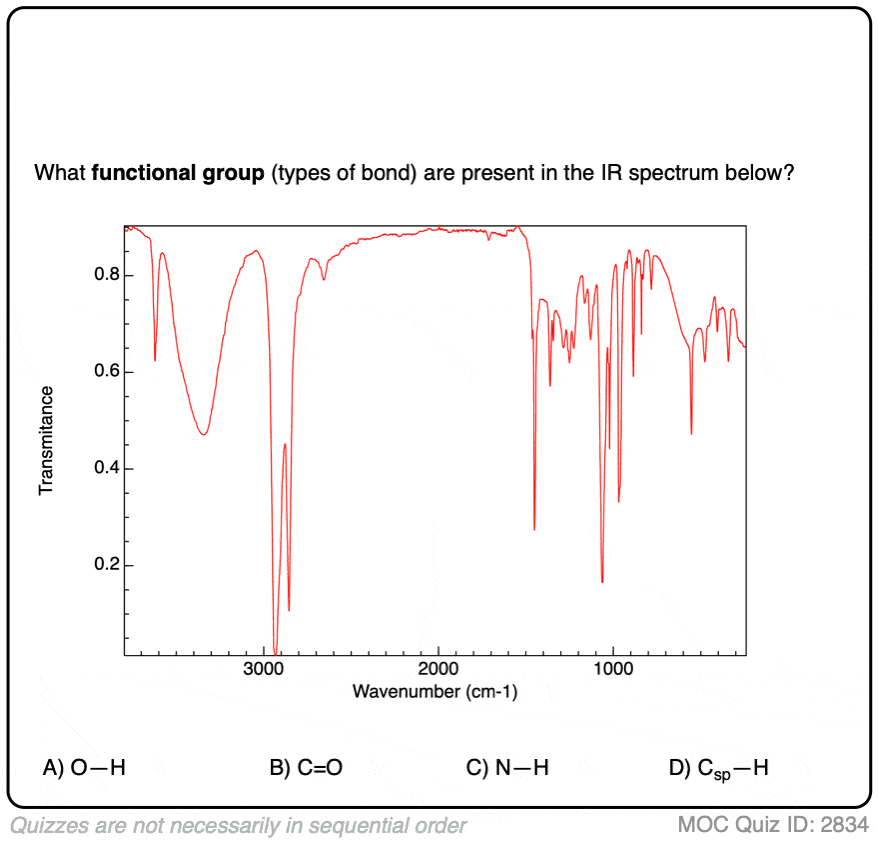 Click to Flip
Click to Flip
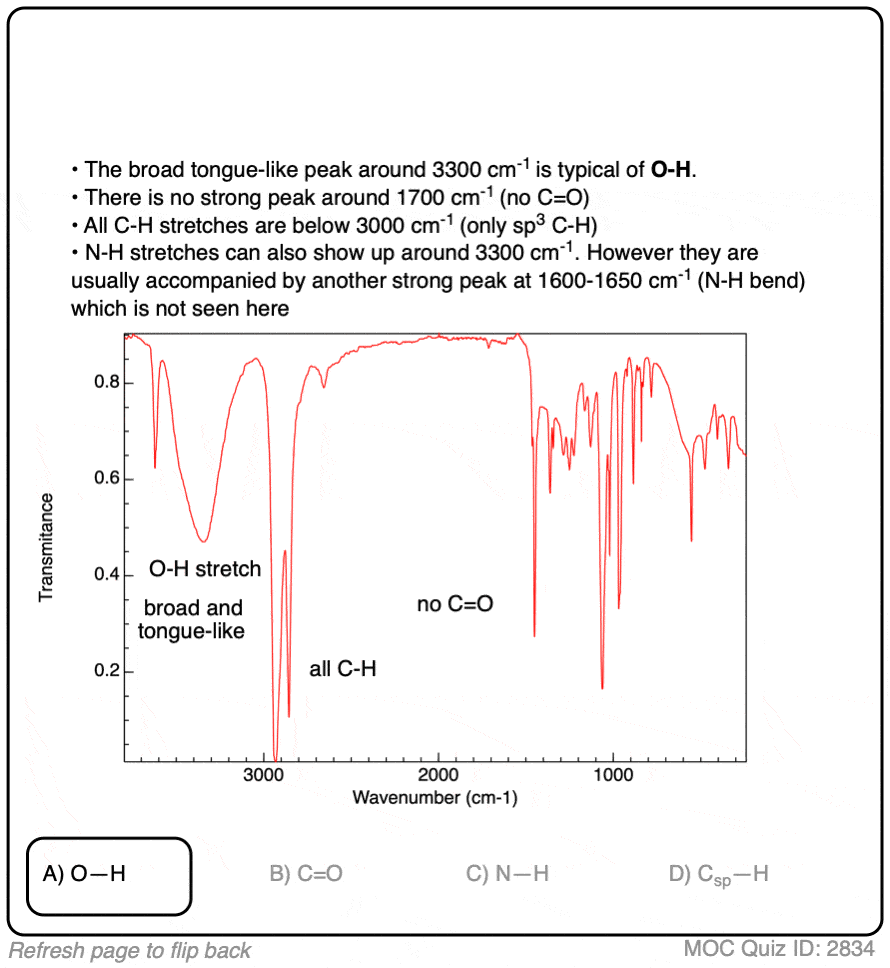
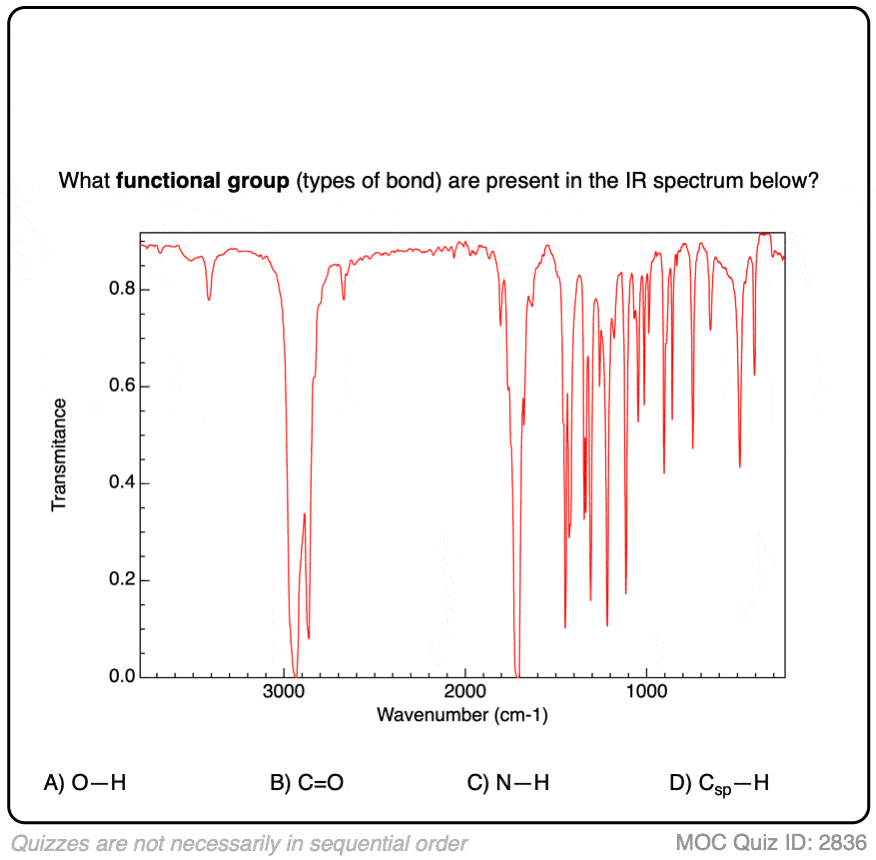 Click to Flip
Click to Flip
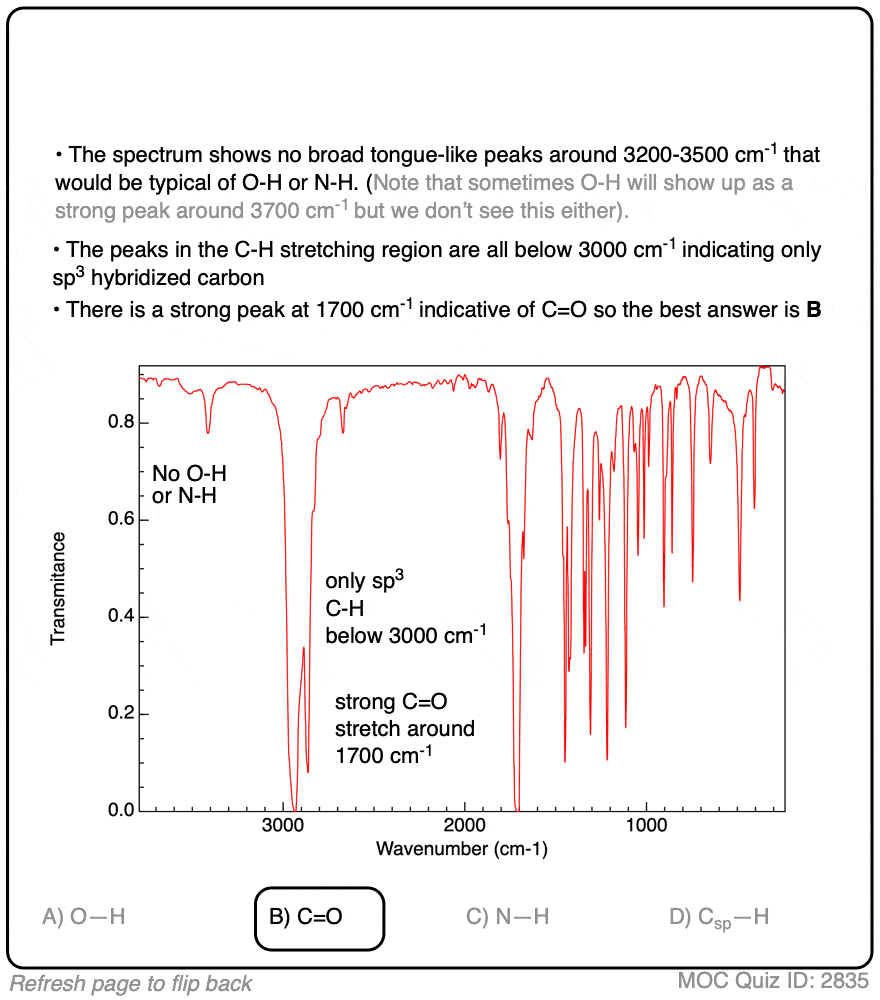
Quiz#: 2836
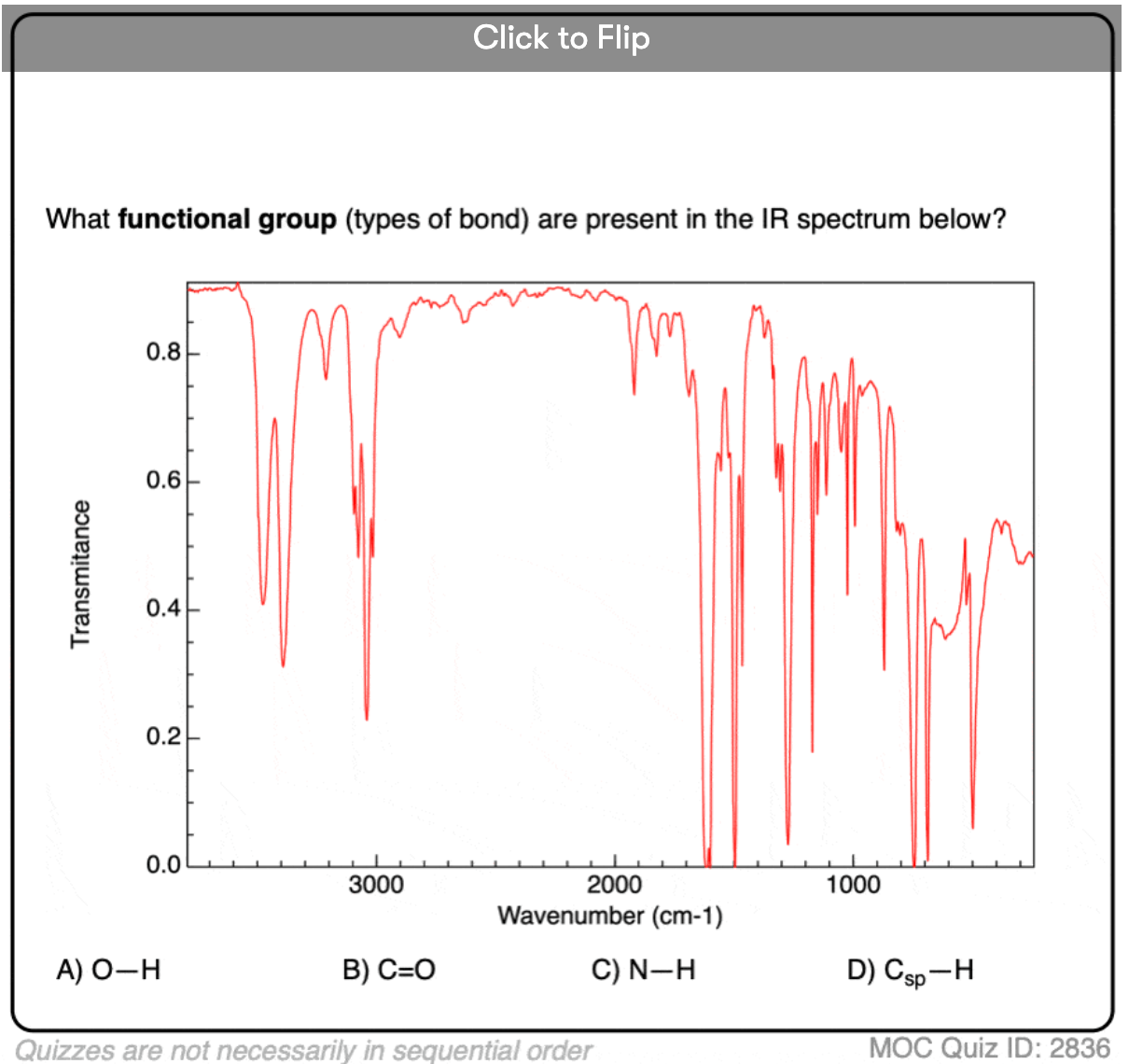
Become a MOC member to see the clickable quiz with answers on the back.
Quiz#: 2837
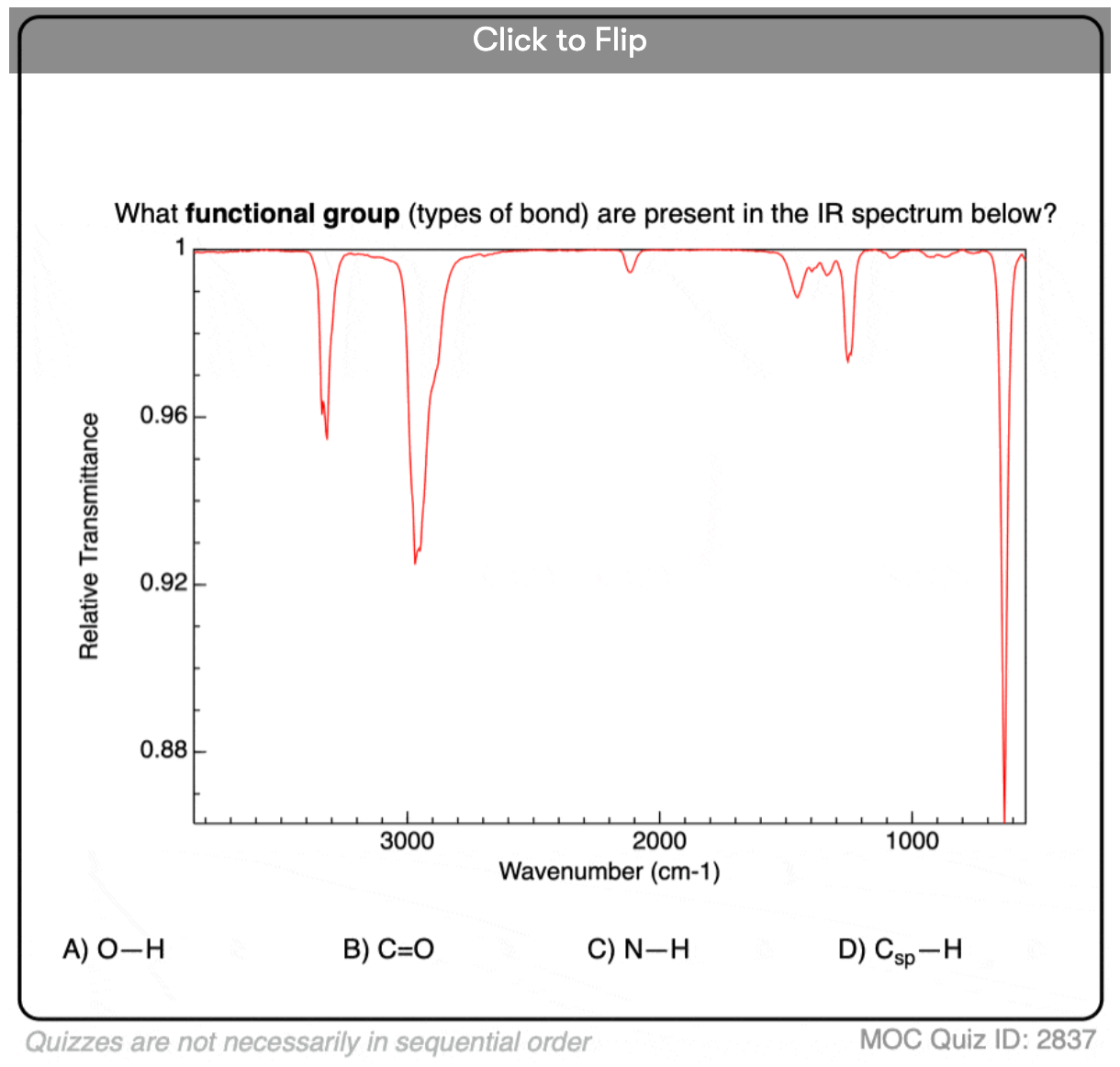
Become a MOC member to see the clickable quiz with answers on the back.
Quiz#: 2838
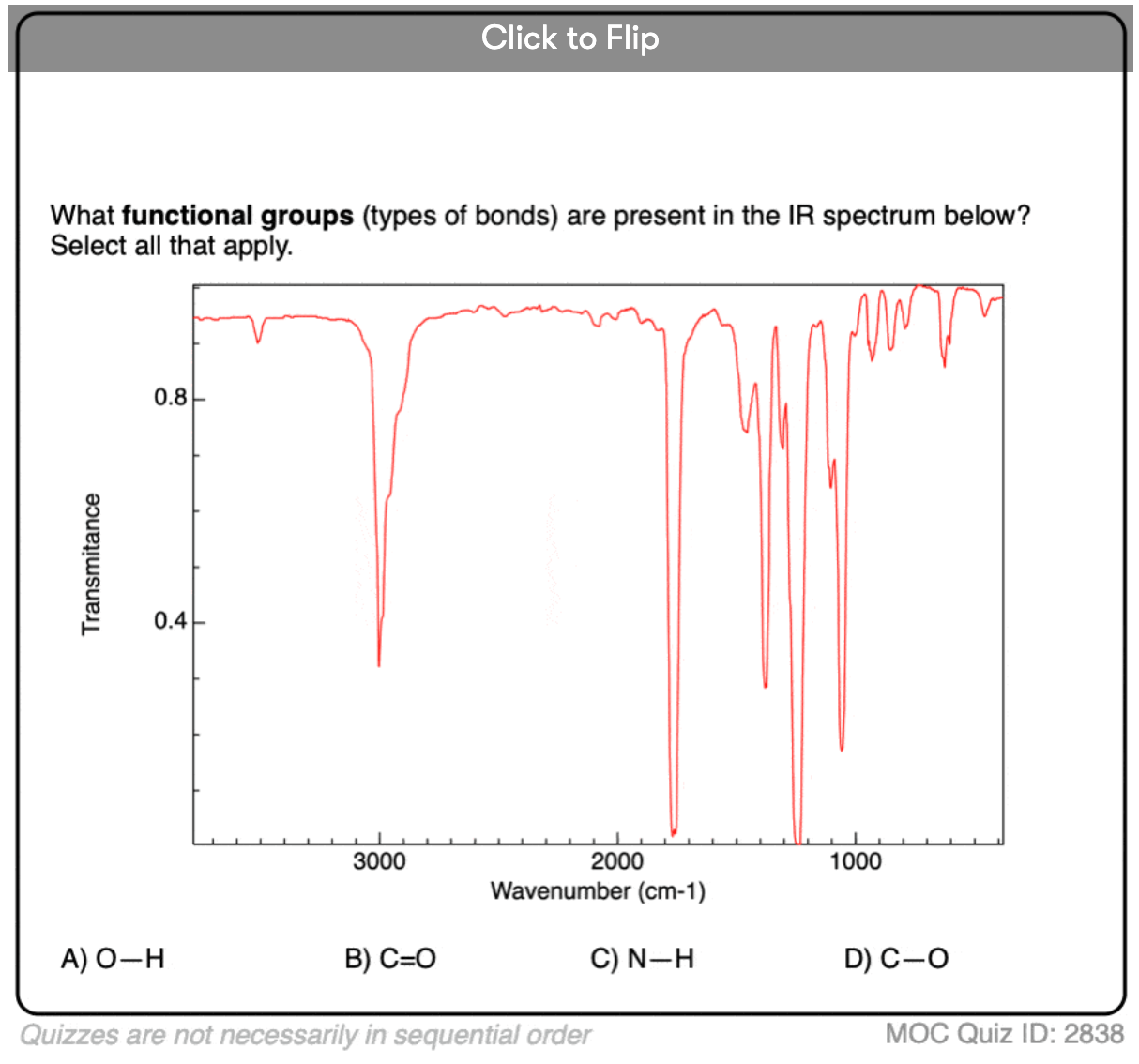
Become a MOC member to see the clickable quiz with answers on the back.
Notes
Related Articles
More on the 3200 region: Amines, Amides, and Terminal Alkyne C-H
While we’re in the 3200 region…. Amines and Amides
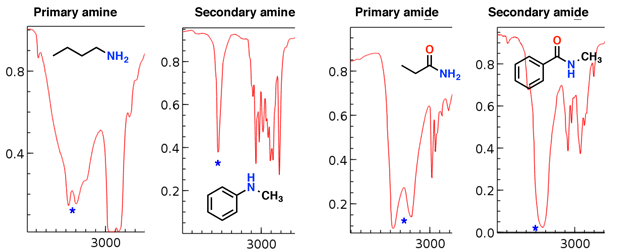
Amines and amides also have N-H stretches which show up in this region. [update: a comment from Paul Wenthold mentions some helpful advice about amides – they are rare – look for confirming evidence from the mass spectrum or other sources before assigning an amide based on a stretch in this region, as this region can also contain carbonyl “overtone” peaks]
Notice how the primary amine and primary amide have two “fangs”, while the secondary amine and secondary amide have a single peak.
The amine stretches tend to be sharper than the amide stretches; also the amides can be distinguished by a strong C=O stretch (see below).
Primary amines (click for spectra)
Secondary amines:
Primary amides
Secondary amides
Terminal alkyne C-H
Terminal alkynes have a characteristic C-H stretch around 3300 cm-1. Here it is for ethynylbenzene, below.
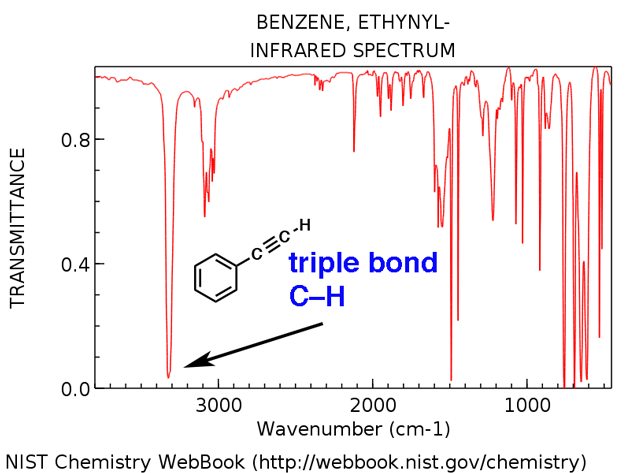
00 General Chemistry Review
01 Bonding, Structure, and Resonance
- How Do We Know Methane (CH4) Is Tetrahedral?
- Hybrid Orbitals and Hybridization
- How To Determine Hybridization: A Shortcut
- Orbital Hybridization And Bond Strengths
- Sigma bonds come in six varieties: Pi bonds come in one
- Dipole Moments and Dipoles
- A Key Skill: How to Calculate Formal Charge
- The Four Intermolecular Forces and How They Affect Boiling Points
- 3 Trends That Affect Boiling Points
- How To Use Electronegativity To Determine Electron Density (and why NOT to trust formal charge)
- Introduction to Resonance
- How To Use Curved Arrows To Interchange Resonance Forms
- Evaluating Resonance Forms (1) - The Rule of Least Charges
- How To Find The Best Resonance Structure By Applying Electronegativity
- Evaluating Resonance Structures With Negative Charges
- Evaluating Resonance Structures With Positive Charge
- Exploring Resonance: Pi-Donation
- Exploring Resonance: Pi-acceptors
- In Summary: Evaluating Resonance Structures
- Drawing Resonance Structures: 3 Common Mistakes To Avoid
- How to apply electronegativity and resonance to understand reactivity
- Bond Hybridization Practice
- Structure and Bonding Practice Quizzes
- Resonance Structures Practice
02 Acid Base Reactions
- Introduction to Acid-Base Reactions
- Acid Base Reactions In Organic Chemistry
- The Stronger The Acid, The Weaker The Conjugate Base
- Walkthrough of Acid-Base Reactions (3) - Acidity Trends
- Five Key Factors That Influence Acidity
- Acid-Base Reactions: Introducing Ka and pKa
- How to Use a pKa Table
- The pKa Table Is Your Friend
- A Handy Rule of Thumb for Acid-Base Reactions
- Acid Base Reactions Are Fast
- pKa Values Span 60 Orders Of Magnitude
- How Protonation and Deprotonation Affect Reactivity
- Acid Base Practice Problems
03 Alkanes and Nomenclature
- Meet the (Most Important) Functional Groups
- Condensed Formulas: Deciphering What the Brackets Mean
- Hidden Hydrogens, Hidden Lone Pairs, Hidden Counterions
- Don't Be Futyl, Learn The Butyls
- Primary, Secondary, Tertiary, Quaternary In Organic Chemistry
- Branching, and Its Affect On Melting and Boiling Points
- The Many, Many Ways of Drawing Butane
- Wedge And Dash Convention For Tetrahedral Carbon
- Common Mistakes in Organic Chemistry: Pentavalent Carbon
- Table of Functional Group Priorities for Nomenclature
- Summary Sheet - Alkane Nomenclature
- Organic Chemistry IUPAC Nomenclature Demystified With A Simple Puzzle Piece Approach
- Boiling Point Quizzes
- Organic Chemistry Nomenclature Quizzes
04 Conformations and Cycloalkanes
- Staggered vs Eclipsed Conformations of Ethane
- Conformational Isomers of Propane
- Newman Projection of Butane (and Gauche Conformation)
- Introduction to Cycloalkanes
- Geometric Isomers In Small Rings: Cis And Trans Cycloalkanes
- Calculation of Ring Strain In Cycloalkanes
- Cycloalkanes - Ring Strain In Cyclopropane And Cyclobutane
- Cyclohexane Conformations
- Cyclohexane Chair Conformation: An Aerial Tour
- How To Draw The Cyclohexane Chair Conformation
- The Cyclohexane Chair Flip
- The Cyclohexane Chair Flip - Energy Diagram
- Substituted Cyclohexanes - Axial vs Equatorial
- Ranking The Bulkiness Of Substituents On Cyclohexanes: "A-Values"
- Cyclohexane Chair Conformation Stability: Which One Is Lower Energy?
- Fused Rings - Cis-Decalin and Trans-Decalin
- Naming Bicyclic Compounds - Fused, Bridged, and Spiro
- Bredt's Rule (And Summary of Cycloalkanes)
- Newman Projection Practice
- Cycloalkanes Practice Problems
05 A Primer On Organic Reactions
- The Most Important Question To Ask When Learning a New Reaction
- Curved Arrows (for reactions)
- Nucleophiles and Electrophiles
- The Three Classes of Nucleophiles
- Nucleophilicity vs. Basicity
- What Makes A Good Nucleophile?
- What Makes A Good Leaving Group?
- 3 Factors That Stabilize Carbocations
- Equilibrium and Energy Relationships
- 7 Factors that stabilize negative charge in organic chemistry
- 7 Factors That Stabilize Positive Charge in Organic Chemistry
- What's a Transition State?
- Hammond's Postulate
- Learning Organic Chemistry Reactions: A Checklist (PDF)
06 Free Radical Reactions
- Free Radical Reactions
- 3 Factors That Stabilize Free Radicals
- Bond Strengths And Radical Stability
- Free Radical Initiation: Why Is "Light" Or "Heat" Required?
- Initiation, Propagation, Termination
- Monochlorination Products Of Propane, Pentane, And Other Alkanes
- Selectivity In Free Radical Reactions
- Selectivity in Free Radical Reactions: Bromination vs. Chlorination
- Halogenation At Tiffany's
- Allylic Bromination
- Bonus Topic: Allylic Rearrangements
- In Summary: Free Radicals
- Synthesis (2) - Reactions of Alkanes
- Free Radicals Practice Quizzes
07 Stereochemistry and Chirality
- Types of Isomers: Constitutional Isomers, Stereoisomers, Enantiomers, and Diastereomers
- How To Draw The Enantiomer Of A Chiral Molecule
- How To Draw A Bond Rotation
- Introduction to Assigning (R) and (S): The Cahn-Ingold-Prelog Rules
- Assigning Cahn-Ingold-Prelog (CIP) Priorities (2) - The Method of Dots
- Enantiomers vs Diastereomers vs The Same? Two Methods For Solving Problems
- Assigning R/S To Newman Projections (And Converting Newman To Line Diagrams)
- How To Determine R and S Configurations On A Fischer Projection
- The Meso Trap
- Optical Rotation, Optical Activity, and Specific Rotation
- Optical Purity and Enantiomeric Excess
- What's a Racemic Mixture?
- Chiral Allenes And Chiral Axes
- Stereochemistry Practice Problems and Quizzes
08 Substitution Reactions
- Nucleophilic Substitution Reactions - Introduction
- Two Types of Nucleophilic Substitution Reactions
- The SN2 Mechanism
- Why the SN2 Reaction Is Powerful
- The SN1 Mechanism
- The Conjugate Acid Is A Better Leaving Group
- Comparing the SN1 and SN2 Reactions
- Polar Protic? Polar Aprotic? Nonpolar? All About Solvents
- Steric Hindrance is Like a Fat Goalie
- Common Blind Spot: Intramolecular Reactions
- Substitution Practice - SN1
- Substitution Practice - SN2
09 Elimination Reactions
- Elimination Reactions (1): Introduction And The Key Pattern
- Elimination Reactions (2): The Zaitsev Rule
- Elimination Reactions Are Favored By Heat
- Two Elimination Reaction Patterns
- The E1 Reaction
- The E2 Mechanism
- E1 vs E2: Comparing the E1 and E2 Reactions
- Antiperiplanar Relationships: The E2 Reaction and Cyclohexane Rings
- Bulky Bases in Elimination Reactions
- Comparing the E1 vs SN1 Reactions
- Elimination (E1) Reactions With Rearrangements
- E1cB - Elimination (Unimolecular) Conjugate Base
- Elimination (E1) Practice Problems And Solutions
- Elimination (E2) Practice Problems and Solutions
10 Rearrangements
11 SN1/SN2/E1/E2 Decision
- Identifying Where Substitution and Elimination Reactions Happen
- Deciding SN1/SN2/E1/E2 (1) - The Substrate
- Deciding SN1/SN2/E1/E2 (2) - The Nucleophile/Base
- SN1 vs E1 and SN2 vs E2 : The Temperature
- Deciding SN1/SN2/E1/E2 - The Solvent
- Wrapup: The Key Factors For Determining SN1/SN2/E1/E2
- Alkyl Halide Reaction Map And Summary
- SN1 SN2 E1 E2 Practice Problems
12 Alkene Reactions
- E and Z Notation For Alkenes (+ Cis/Trans)
- Alkene Stability
- Alkene Addition Reactions: "Regioselectivity" and "Stereoselectivity" (Syn/Anti)
- Stereoselective and Stereospecific Reactions
- Hydrohalogenation of Alkenes and Markovnikov's Rule
- Hydration of Alkenes With Aqueous Acid
- Rearrangements in Alkene Addition Reactions
- Halogenation of Alkenes and Halohydrin Formation
- Oxymercuration Demercuration of Alkenes
- Hydroboration Oxidation of Alkenes
- m-CPBA (meta-chloroperoxybenzoic acid)
- OsO4 (Osmium Tetroxide) for Dihydroxylation of Alkenes
- Palladium on Carbon (Pd/C) for Catalytic Hydrogenation of Alkenes
- Cyclopropanation of Alkenes
- A Fourth Alkene Addition Pattern - Free Radical Addition
- Alkene Reactions: Ozonolysis
- Oxidative Cleavage of Vicinal Diols With NaIO4 and Pb(OAc)4
- Summary: Three Key Families Of Alkene Reaction Mechanisms
- Synthesis (4) - Alkene Reaction Map, Including Alkyl Halide Reactions
- Alkene Reactions Practice Problems
13 Alkyne Reactions
- Acetylides from Alkynes, And Substitution Reactions of Acetylides
- Partial Reduction of Alkynes With Lindlar's Catalyst
- Partial Reduction of Alkynes With Na/NH3 To Obtain Trans Alkenes
- Alkyne Hydroboration With "R2BH"
- Hydration and Oxymercuration of Alkynes
- Hydrohalogenation of Alkynes
- Alkyne Halogenation: Bromination and Chlorination of Alkynes
- Oxidation of Alkynes With O3 and KMnO4
- Alkenes To Alkynes Via Halogenation And Elimination Reactions
- Alkynes Are A Blank Canvas
- Synthesis (5) - Reactions of Alkynes
- Alkyne Reactions Practice Problems With Answers
14 Alcohols, Epoxides and Ethers
- Alcohols - Nomenclature and Properties
- Alcohols Can Act As Acids Or Bases (And Why It Matters)
- Alcohols - Acidity and Basicity
- The Williamson Ether Synthesis
- Ethers From Alkenes, Tertiary Alkyl Halides and Alkoxymercuration
- Alcohols To Ethers via Acid Catalysis
- Cleavage Of Ethers With Acid
- Epoxides - The Outlier Of The Ether Family
- Opening of Epoxides With Acid
- Epoxide Ring Opening With Base
- Making Alkyl Halides From Alcohols
- Tosylates And Mesylates
- PBr3 and SOCl2
- Elimination Reactions of Alcohols
- Elimination of Alcohols To Alkenes With POCl3
- Alcohol Oxidation: "Strong" and "Weak" Oxidants
- Demystifying The Mechanisms of Alcohol Oxidations
- Protecting Groups For Alcohols
- Thiols And Thioethers
- Calculating the oxidation state of a carbon
- Oxidation and Reduction in Organic Chemistry
- Oxidation Ladders
- SOCl2 Mechanism For Alcohols To Alkyl Halides: SN2 versus SNi
- Alcohol Reactions Roadmap (PDF)
- Alcohol Reaction Practice Problems
- Epoxide Reaction Quizzes
- Oxidation and Reduction Practice Quizzes
15 Organometallics
- What's An Organometallic?
- Formation of Grignard and Organolithium Reagents
- Organometallics Are Strong Bases
- Reactions of Grignard Reagents
- Protecting Groups In Grignard Reactions
- Synthesis Problems Involving Grignard Reagents
- Grignard Reactions And Synthesis (2)
- Organocuprates (Gilman Reagents): How They're Made
- Gilman Reagents (Organocuprates): What They're Used For
- The Heck, Suzuki, and Olefin Metathesis Reactions (And Why They Don't Belong In Most Introductory Organic Chemistry Courses)
- Reaction Map: Reactions of Organometallics
- Grignard Practice Problems
16 Spectroscopy
- Degrees of Unsaturation (or IHD, Index of Hydrogen Deficiency)
- Conjugation And Color (+ How Bleach Works)
- Introduction To UV-Vis Spectroscopy
- UV-Vis Spectroscopy: Absorbance of Carbonyls
- UV-Vis Spectroscopy: Practice Questions
- Bond Vibrations, Infrared Spectroscopy, and the "Ball and Spring" Model
- Infrared (IR) Spectroscopy: A Quick Primer On Interpreting Spectra
- IR Spectroscopy: 4 Practice Problems
- 1H NMR: How Many Signals?
- Homotopic, Enantiotopic, Diastereotopic
- Diastereotopic Protons in 1H NMR Spectroscopy: Examples
- 13-C NMR - How Many Signals
- Liquid Gold: Pheromones In Doe Urine
- Natural Product Isolation (1) - Extraction
- Natural Product Isolation (2) - Purification Techniques, An Overview
- Structure Determination Case Study: Deer Tarsal Gland Pheromone
17 Dienes and MO Theory
- What To Expect In Organic Chemistry 2
- Are these molecules conjugated?
- Conjugation And Resonance In Organic Chemistry
- Bonding And Antibonding Pi Orbitals
- Molecular Orbitals of The Allyl Cation, Allyl Radical, and Allyl Anion
- Pi Molecular Orbitals of Butadiene
- Reactions of Dienes: 1,2 and 1,4 Addition
- Thermodynamic and Kinetic Products
- More On 1,2 and 1,4 Additions To Dienes
- s-cis and s-trans
- The Diels-Alder Reaction
- Cyclic Dienes and Dienophiles in the Diels-Alder Reaction
- Stereochemistry of the Diels-Alder Reaction
- Exo vs Endo Products In The Diels Alder: How To Tell Them Apart
- HOMO and LUMO In the Diels Alder Reaction
- Why Are Endo vs Exo Products Favored in the Diels-Alder Reaction?
- Diels-Alder Reaction: Kinetic and Thermodynamic Control
- The Retro Diels-Alder Reaction
- The Intramolecular Diels Alder Reaction
- Regiochemistry In The Diels-Alder Reaction
- The Cope and Claisen Rearrangements
- Electrocyclic Reactions
- Electrocyclic Ring Opening And Closure (2) - Six (or Eight) Pi Electrons
- Diels Alder Practice Problems
- Molecular Orbital Theory Practice
18 Aromaticity
- Introduction To Aromaticity
- Rules For Aromaticity
- Huckel's Rule: What Does 4n+2 Mean?
- Aromatic, Non-Aromatic, or Antiaromatic? Some Practice Problems
- Antiaromatic Compounds and Antiaromaticity
- The Pi Molecular Orbitals of Benzene
- The Pi Molecular Orbitals of Cyclobutadiene
- Frost Circles
- Aromaticity Practice Quizzes
19 Reactions of Aromatic Molecules
- Electrophilic Aromatic Substitution: Introduction
- Activating and Deactivating Groups In Electrophilic Aromatic Substitution
- Electrophilic Aromatic Substitution - The Mechanism
- Ortho-, Para- and Meta- Directors in Electrophilic Aromatic Substitution
- Understanding Ortho, Para, and Meta Directors
- Why are halogens ortho- para- directors?
- Disubstituted Benzenes: The Strongest Electron-Donor "Wins"
- Electrophilic Aromatic Substitutions (1) - Halogenation of Benzene
- Electrophilic Aromatic Substitutions (2) - Nitration and Sulfonation
- EAS Reactions (3) - Friedel-Crafts Acylation and Friedel-Crafts Alkylation
- Intramolecular Friedel-Crafts Reactions
- Nucleophilic Aromatic Substitution (NAS)
- Nucleophilic Aromatic Substitution (2) - The Benzyne Mechanism
- Reactions on the "Benzylic" Carbon: Bromination And Oxidation
- The Wolff-Kishner, Clemmensen, And Other Carbonyl Reductions
- More Reactions on the Aromatic Sidechain: Reduction of Nitro Groups and the Baeyer Villiger
- Aromatic Synthesis (1) - "Order Of Operations"
- Synthesis of Benzene Derivatives (2) - Polarity Reversal
- Aromatic Synthesis (3) - Sulfonyl Blocking Groups
- Birch Reduction
- Synthesis (7): Reaction Map of Benzene and Related Aromatic Compounds
- Aromatic Reactions and Synthesis Practice
- Electrophilic Aromatic Substitution Practice Problems
20 Aldehydes and Ketones
- What's The Alpha Carbon In Carbonyl Compounds?
- Nucleophilic Addition To Carbonyls
- Aldehydes and Ketones: 14 Reactions With The Same Mechanism
- Sodium Borohydride (NaBH4) Reduction of Aldehydes and Ketones
- Grignard Reagents For Addition To Aldehydes and Ketones
- Wittig Reaction
- Hydrates, Hemiacetals, and Acetals
- Imines - Properties, Formation, Reactions, and Mechanisms
- All About Enamines
- Breaking Down Carbonyl Reaction Mechanisms: Reactions of Anionic Nucleophiles (Part 2)
- Aldehydes Ketones Reaction Practice
21 Carboxylic Acid Derivatives
- Nucleophilic Acyl Substitution (With Negatively Charged Nucleophiles)
- Addition-Elimination Mechanisms With Neutral Nucleophiles (Including Acid Catalysis)
- Basic Hydrolysis of Esters - Saponification
- Transesterification
- Proton Transfer
- Fischer Esterification - Carboxylic Acid to Ester Under Acidic Conditions
- Lithium Aluminum Hydride (LiAlH4) For Reduction of Carboxylic Acid Derivatives
- LiAlH[Ot-Bu]3 For The Reduction of Acid Halides To Aldehydes
- Di-isobutyl Aluminum Hydride (DIBAL) For The Partial Reduction of Esters and Nitriles
- Amide Hydrolysis
- Thionyl Chloride (SOCl2) And Conversion of Carboxylic Acids to Acid Halides
- Diazomethane (CH2N2)
- Carbonyl Chemistry: Learn Six Mechanisms For the Price Of One
- Making Music With Mechanisms (PADPED)
- Carboxylic Acid Derivatives Practice Questions
22 Enols and Enolates
- Keto-Enol Tautomerism
- Enolates - Formation, Stability, and Simple Reactions
- Kinetic Versus Thermodynamic Enolates
- Aldol Addition and Condensation Reactions
- Reactions of Enols - Acid-Catalyzed Aldol, Halogenation, and Mannich Reactions
- Claisen Condensation and Dieckmann Condensation
- Decarboxylation
- The Malonic Ester and Acetoacetic Ester Synthesis
- The Michael Addition Reaction and Conjugate Addition
- The Robinson Annulation
- Haloform Reaction
- The Hell–Volhard–Zelinsky Reaction
- Enols and Enolates Practice Quizzes
23 Amines
- The Amide Functional Group: Properties, Synthesis, and Nomenclature
- Basicity of Amines And pKaH
- 5 Key Basicity Trends of Amines
- The Mesomeric Effect And Aromatic Amines
- Nucleophilicity of Amines
- Alkylation of Amines (Sucks!)
- Reductive Amination
- The Gabriel Synthesis
- Some Reactions of Azides
- The Hofmann Elimination
- The Hofmann and Curtius Rearrangements
- The Cope Elimination
- Protecting Groups for Amines - Carbamates
- The Strecker Synthesis of Amino Acids
- Introduction to Peptide Synthesis
- Reactions of Diazonium Salts: Sandmeyer and Related Reactions
- Amine Practice Questions
24 Carbohydrates
- D and L Notation For Sugars
- Pyranoses and Furanoses: Ring-Chain Tautomerism In Sugars
- What is Mutarotation?
- Reducing Sugars
- The Big Damn Post Of Carbohydrate-Related Chemistry Definitions
- The Haworth Projection
- Converting a Fischer Projection To A Haworth (And Vice Versa)
- Reactions of Sugars: Glycosylation and Protection
- The Ruff Degradation and Kiliani-Fischer Synthesis
- Isoelectric Points of Amino Acids (and How To Calculate Them)
- Carbohydrates Practice
- Amino Acid Quizzes
25 Fun and Miscellaneous
- A Gallery of Some Interesting Molecules From Nature
- Screw Organic Chemistry, I'm Just Going To Write About Cats
- On Cats, Part 1: Conformations and Configurations
- On Cats, Part 2: Cat Line Diagrams
- On Cats, Part 4: Enantiocats
- On Cats, Part 6: Stereocenters
- Organic Chemistry Is Shit
- The Organic Chemistry Behind "The Pill"
- Maybe they should call them, "Formal Wins" ?
- Why Do Organic Chemists Use Kilocalories?
- The Principle of Least Effort
- Organic Chemistry GIFS - Resonance Forms
- Reproducibility In Organic Chemistry
- What Holds The Nucleus Together?
- How Reactions Are Like Music
- Organic Chemistry and the New MCAT
26 Organic Chemistry Tips and Tricks
- Common Mistakes: Formal Charges Can Mislead
- Partial Charges Give Clues About Electron Flow
- Draw The Ugly Version First
- Organic Chemistry Study Tips: Learn the Trends
- The 8 Types of Arrows In Organic Chemistry, Explained
- Top 10 Skills To Master Before An Organic Chemistry 2 Final
- Common Mistakes with Carbonyls: Carboxylic Acids... Are Acids!
- Planning Organic Synthesis With "Reaction Maps"
- Alkene Addition Pattern #1: The "Carbocation Pathway"
- Alkene Addition Pattern #2: The "Three-Membered Ring" Pathway
- Alkene Addition Pattern #3: The "Concerted" Pathway
- Number Your Carbons!
- The 4 Major Classes of Reactions in Org 1
- How (and why) electrons flow
- Grossman's Rule
- Three Exam Tips
- A 3-Step Method For Thinking Through Synthesis Problems
- Putting It Together
- Putting Diels-Alder Products in Perspective
- The Ups and Downs of Cyclohexanes
- The Most Annoying Exceptions in Org 1 (Part 1)
- The Most Annoying Exceptions in Org 1 (Part 2)
- The Marriage May Be Bad, But the Divorce Still Costs Money
- 9 Nomenclature Conventions To Know
- Nucleophile attacks Electrophile
27 Case Studies of Successful O-Chem Students
- Success Stories: How Corina Got The The "Hard" Professor - And Got An A+ Anyway
- How Helena Aced Organic Chemistry
- From a "Drop" To B+ in Org 2 – How A Hard Working Student Turned It Around
- How Serge Aced Organic Chemistry
- Success Stories: How Zach Aced Organic Chemistry 1
- Success Stories: How Kari Went From C– to B+
- How Esther Bounced Back From a "C" To Get A's In Organic Chemistry 1 And 2
- How Tyrell Got The Highest Grade In Her Organic Chemistry Course
- This Is Why Students Use Flashcards
- Success Stories: How Stu Aced Organic Chemistry
- How John Pulled Up His Organic Chemistry Exam Grades
- Success Stories: How Nathan Aced Organic Chemistry (Without It Taking Over His Life)
- How Chris Aced Org 1 and Org 2
- Interview: How Jay Got an A+ In Organic Chemistry
- How to Do Well in Organic Chemistry: One Student's Advice
- "America's Top TA" Shares His Secrets For Teaching O-Chem
- "Organic Chemistry Is Like..." - A Few Metaphors
- How To Do Well In Organic Chemistry: Advice From A Tutor
- Guest post: "I went from being afraid of tests to actually looking forward to them".
This article is very helpful for me. Thanks a lot.
Excellent.This is so useful.
Thank you so much for this. We cover so much material so quickly that it is easy to get lost in the sheer volume of it. It really helps to have things distilled into a more digestible and condensed format.
Thank you for this! May I ask, what if I would like to check whether Iron had been impregnated in my activated carbon? My study is FeCl3-impregnated activated carbon from coffee wastes. I have an IR spectra for the raw coffee waste and IR for the FeCl3- impregnated and thermally treated (700 deg. C) coffee wastes. What would be the expected difference in their spectra?
I don’t know. For trace metal analysis shouldn’t you be doing something like ICP or other techniques?
Ain’t this great! Man you’re an angel
this quick guide is awesome, I’ve learned so much reading it. To recall whatever you forgot over time, this is the best option.
Thank you
Glad you found it useful for refreshing your memory!
This has really been helpful for my studies in chemistry
I am glad you find it helpful Cirona!
This is very helpful
Glad you find it helpful Anand
I love this analysis very much impressive thanks 👍
Glad you find it helpful!
A lifesaver if there was ever one. Infrared Spectroscopy was so confusing for me in undergrad,and post grad had me even more muddled.One look at this article on the morning of the test was enough to make me take my test confidently and do it well! The way you simplified it while highlighting important points is crazy. I was trying to remember all the values given from the typical IR frequency table which wasn’t working at all and was leaving me anxious. Tongues and Swords made it so simple and memorable. Thanks for all that you do and more! This is Monica Rao all the way from India!
Glad to hear you found it useful! I had a similar experience in undergraduate and glad that this simplified things for you!
i love you, you just saved my life
explanation is very easy to understand. thank you
Best Explanation so far. Really helpful
VERY GOOD
This is so helpful thank you
Best Review on IR
Thank you Sagar.
Hi James,
Thank you for your very clear tutorials on interpreting IR spectra. They have been really helpful to me.
I have a few questions regarding a compound with an unknown structure, which I am trying to decipher using FTIR. Would you be happy to have a look at this for me and confirm whether or not I have done it right, based on the information on your tutorials?
Thanks I am newbie and this finally made a pathway in my grey cells :)
Thanks a lot. This has really helped me I understood everything in it
Thank you so much for this great work. I have one problem: I used to work with polymers (in my particular case I am working with PVC films). Firstly, I do an FTIR spectrum of the “as received” PVC film. Next, I carry out a thermal treatment of the PVC film (below its Tg) and repeat the FTIR. The peaks have not change, however the intensity of them is different. I have tried to figure out an explanation for this phenomenon (searching in bibliography), but I didn´t found an answer. Do you have any idea of why this happen?
thank you very much.
You are absolutely amazing. I feel so happy and satisfied reading this. Your style of presenting the context is so good. Thank You for your hard work for us.
Thank you so much. Two month i have struggled about this topic. Full of detail in simple words with various example. Thank you again
I am really grateful this lesson is really awesome.
Thank you so much!! Your post really helped understangding IR :)
Thank you so much for this great information sir
Thank you!! This is so easy explained and helpful. I have one question: How much can I trust in my software suggestions? the software of my FTIR instrumen has some libraries included.
I’m not sure. There can be considerable variability between samples of the same molecule, depending on how the sample is prepared (thickness of film) and the amount of water present (which affects hydrogen bonding). The libraries are a good starting point but not a magic bullet, good when part of a more holistic approach to combine with other information (e.g. HRMS data)
Thanks Paul – I was unaware of the overtones in that region. Very helpful, thank you!
One thing you didn’t mention is the carbonyl overtone peaks, which result when the molecule absorbs two photons of IR light. These show up as weak peaks at 2 x the carbonyl frequency, so are in that 3300 – 3500 range.
It’s important know about this because beginning students very often assign those peaks to NH stretches. And it’s not crazy, because NH stretches in monosubstituted amides can be relatively weak, so it can be difficult to distinguish them.
This isn’t perfect, but, from an instructor perspective, my advice is to avoid the urge to assign them to amine or amide. If you see a carbonyl, expect to see that overtone and don’t call it an NH stretch. Now, this means you might miss an amide, but that alone is not sufficient to conclude it is amide. You would need to verify it by other means. As noted, amide C=O stretches tend to be lower energy than other functional groups, but even then I’d be careful about putting too fine a point on it (absorptions usually come in ranges, not in specific spots – the C=O is 1680: does that mean it’s amide? Could be, but it could also be a ketone at the edge of its range; it’s consistent with both). Now, if you have a mass spectrum that indicates the presence of a N (by having an odd molecular mass), so you know N is present, then sure, it could be NH stretching. But absent other information that indicates an amide, my advice is don’t go that direction.
This is the best review I have ever seen-splendid!
This is an excellent resource on IR for a newbie…love to give this to my students for reading. Looking for posts on mass spectrometry..
Thanks Anju – appreciate it. This is what I wish someone told me when I was learning how to interpret IR spectra.
Very clear, lots of examples and well thought out instructions. I feel so much more confident! Thank you soo much!!!
Great! So glad you feel more confident!
Symply excellent. Please, we need MOC Text book.
Not happening! But thank you
Seriously it is the best of all explanation I have seen ,it really helpful 💖
Very helpful. I can understand the materials much better
Thanks for the wonderful lecture, my question is how can one identify aromatic or the benzene ring absorption. Please I also need your email address
Look for the C-H bond stretch below 3000 cm-1. It is not specific for the aromatic ring but at least points to an sp2 hybridized carbon bonded to H.
saved my life honestly.
Honestly? Awesome!
Best explanation ever ! The only one I understood .. Thank you a lot!
Thanks Olivia! Glad you found it helpful!
I was completely lost at lecture on IR but after reading this, i realized its simple things made difficult. You saved me a failure.
So glad to hear it Josan.
Thanks! This article saved me. Recommended this to all my friends.
Thanks for letting me know Harshit!
Wow! Thanks – you will never know how much time this saved me.
So glad to hear it Freeman.
Excellent explanation! Thank you for all the hard work.
Thanks Zeke!
Thank you! you just saved my life
If it made IR less painful, that’s awesome Alejandra!
I see nothing about <500 cm-1 which is what I need to know
Really? I wish I had a better answer for you. The region below 500 cm-1 is an “enduring mystery” for many of us. https://amphoteros.com/2019/01/18/an-enduring-mystery/
Loved this!!!!!
Great!
THANK YOU!!!! THIS SAVED MY LIFE!!!!!!
Hooray!
I know your faculty plans did not work out, but you are so better than many professors! Thank you! Never stop chasing your dreams!
Beautifully explained Sir !!
Best explanation of IR spectra I’ve came across.
Waiting for your next post :)
Thanks!
I completely agree with the above posts.
You should Youtube as well my friend. Great job!
I do have a Youtube channel but it has been quite neglected!
I COMPLETELY AGREE 100% with the previous praises and comments – you have been a SAVING grace in my organic chemistry understanding and I appreciate your approach in simplifying the most complex things. I have honestly spent 4+hrs in attempting 2 problems in figuring out the structures and feel so much better moving forward. THANK YOU! Keep up the phenomenal job!
Thank you Maribel!
Thanks for such a great focused article. It’s really very helpful.
Tried to make it useful. If it succeeded, great!
This is very clear and understandable even to a layman. Thanks a lot
You’re welcome!
why alkenes group (3000 -3100) & alkyl halides (500 -539) are added to NORYL (PPE + PS) plastic?
which properties are affected?
How do you know the peak in the 3000-3100 isn’t from the styrene?
Thank you so much for this guide! Very thorough approach and great explanation.
Meg – so glad you’ve found it helpful. Put a lot of work into it!
Great work! best I could find in all these years in fact.
Never using another website or youtube vid (unless its yours) for help again. You’re amazing
Beautifully explained!
This is the best review for IR Spectroscopy out there!
THIS IS SO HELPFUL!! so many different examples were used and I understand everything now! Will there be a quick tutorial for carbon and proton NMR as well?